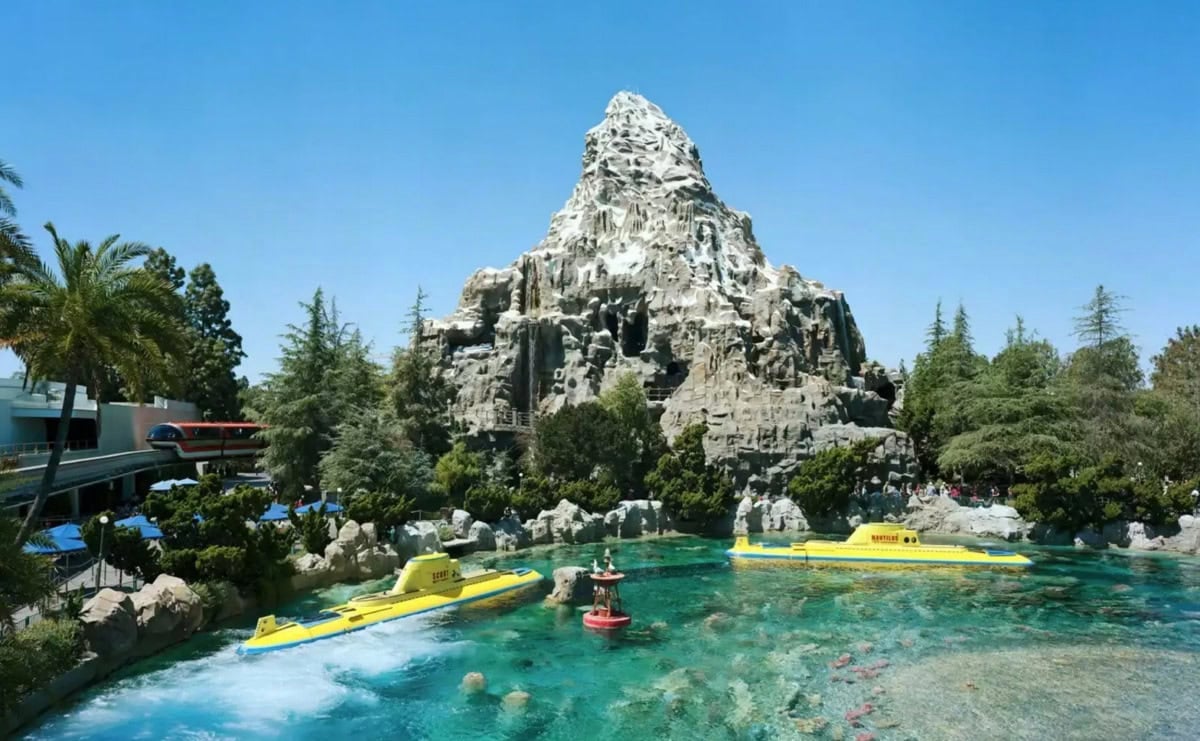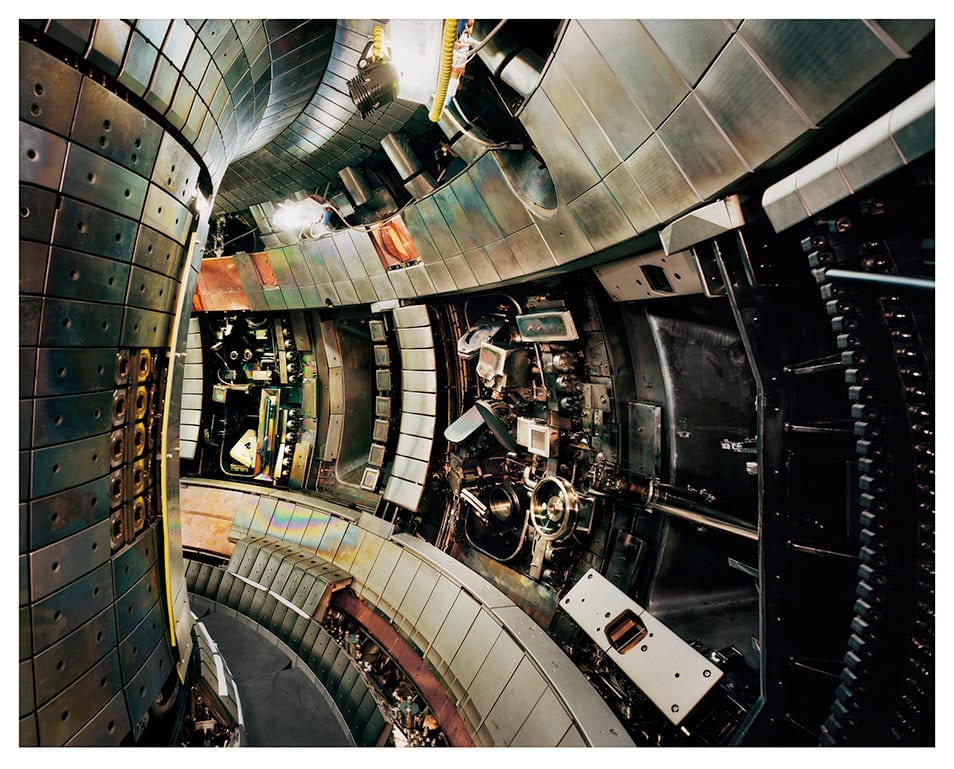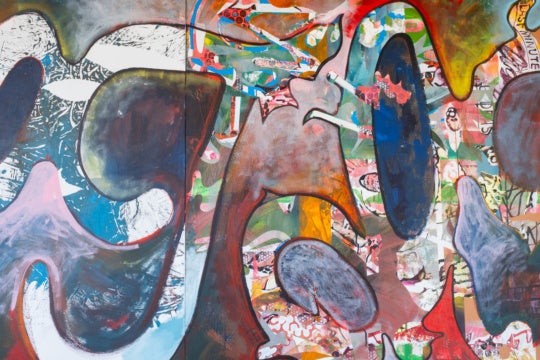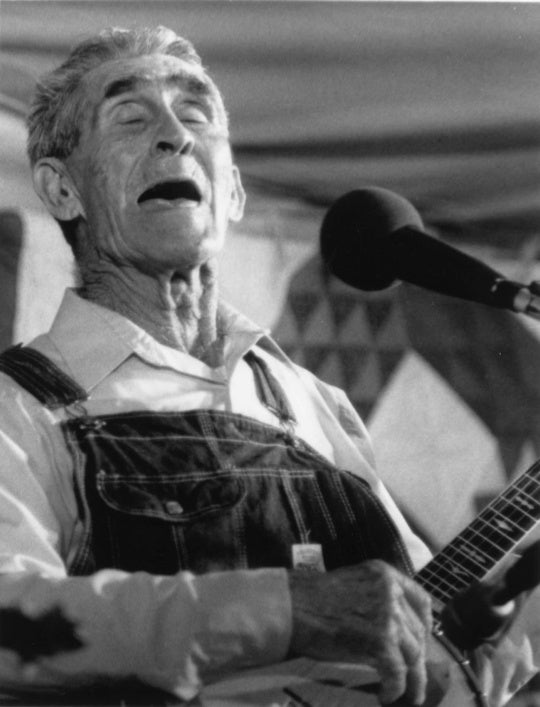
We met with German photographer Thomas Struth as he was installing his new exhibition “Nature and Politics” at the High Museum of Art. The show, which opens on Sunday, October 16, features 30 medium- to large-scale works. Photographed in such locales as Disneyland in Anaheim, California, Cape Canaveral in Florida, various physics and robot labs (including Georgia Tech’s), Charité Hospital in Berlin, and sites in Israel and Palestine, Struth focuses on the places and objects that usually are overlooked or not accessible to the general public.
Instead of grouping works in discrete series, the installation highlights unexpected similarities — visual and thematic — between, for example a fake Disney cave and a plasma physics lab, or brain surgery and space shuttle maintenance.
While the exhibition title seems painfully straightforward, the underlying subject matter and the works on view offer more than meets the eye. “Nature and Politics” was initially a working title in his studio, but, with nature and the environment being politicized, and politics intervening in scientific research and human affairs, and science intervening in the human body and environment, and so on, Struth felt that it said all that needed to be said.
Stephanie Cash: Tell me about this new body of work. Why Disneyland?
Thomas Struth: I had the idea of photographing the original Disneyland, but I thought that would be too strange, so I went on a location-scouting trip to Disney. This photo is a detail of fake rocks and real plants; I’m interested in the ambiguity of what is real and what isn’t.
SC: Many of these images seem ambiguous in other ways too. Some are near abstractions of mechanical equipment that won’t be familiar to most viewers.
TS: The idea for the pictures of technology had to do with the question of progress: what is progress? It has to do with imagination and memory in terms of developing new things from what is known already into unknown. Disney is a place where fantasy and imagination are blandly turned into sculpture, like a fake mountain, a fake cave, a fake canyon, fake rock, and real plants. I find that combination interesting. I photograph them to highlight general questions or problems or challenges that humans deal with.
SC: Where do you place the science and mechanical images on the nature-politics scale? What is it that attracts you to them?
TS: The photos in the lab are kind of plasma physics, and these here have to do with space travel, like the space shuttle Endeavor.
SC: What is the oldest work in the show?
TS: The courtyard in St. Petersburg, Russia, from 2005. The first technology works were at Cape Canaveral, the Max Planck Institute for Plasma Physics in Munich, and my trip to Korea where I photographed that oil rig. What is progress? We are so invested in believing that technological progress is what is important, not human, or political or social progress. That is such a one-sided investment. It bothered me for many years.

SC: And nature is now so political, like whether people think global warming is true or not. What strikes me about some of these images — like the landscapes or the Georgia Aquarium here in Atlanta — is that the field of vision is from a distance. There’s a scene. And then you have others that are very close up and nearly abstract or like still lifes.
TS: As I’m working, I find different things in my subjects and branch out, so the pictorial quality isn’t so strict. When it is strict, it becomes about patterns or something like that. So this one is called Stellarator, which is in the Max Planck Institute. It is almost indecipherable, what it is. Since I am no specialist, I looked at these things as a kind of brain imprint, like a thought that has been cast into sculpture. People have to be able to imagine this first, then turn it into sculpture. I am interested in that process of turning something in the imagination into a sculpture.
SC: That’s a very high-tech piece of equipment, but it looks like a jumble of random parts, yet it makes sense to the people who work on it.
TS: This photo is of the underside of the space shuttle Endeavor in a restoration facility. It is elevated so that the underside, the heat tiles, can be checked by different teams for damage. The dark tiles are the ones that must be replaced, and the stickers with handwriting are communications between the teams to check something. The main subject matter here is the handmade quality of everything.
Technology is always sold to the general public as this ideal, glorious new hope, because otherwise, the public wouldn’t agree to spend money on it. But in general, that is not true. The iPhone or whatever you use is not perfect, nor is it marketed for everything that it really does. For example, if in the beginning the public had known about the mechanisms that allow your every movement to be tracked, only 50 percent of people would’ve bought it, literally and politically.
SC: How do you gain access to these places? Is it very difficult?
TS: In the beginning, people were surprised that I wanted to come and make pictures. But now, I am well known and have had many exhibitions and publications, so I have access to more things.
Three years ago, I thought, I’ve never done anything in the medical field. I have a research assistant — I give her a keyword and then she researches. We found out about the da Vinci remote surgery tool. We found a surgeon who uses it, but the tool was kind of boring, so I asked to see it in action. That’s how I became interested in the medical sector of technology.
Technology is always sold to the general public as this ideal, glorious new hope, because otherwise, the public wouldn’t agree to spend money on it. But in general, that is not true.
SC: What’s happening in this image? It’s kind of disturbing, but you didn’t make it gory or bloody.
TS: This is the belly of the man about to undergo prostate surgery. You see the da Vinci machine wrapped up in plastic hovering over the patient. I was interested in the relationship between the machine and the human figure. I thought there was quite a dramatic expression of hope in the machine.
I wanted to have a second work from the medical field, so we researched again at Charité teaching hospital in Berlin and found a prominent brain surgeon who removes tumors. I talked with him and he invited me to be present at one of his operations, which I watched for about four or five hours. It was a very difficult experience. I made snapshots to see if it was something I could materialize into a picture, but I decided I could not do that anymore. For a year and a half, I didn’t do anything further, but one image from those snapshots kept coming back to me, which was the person before the operation under anesthesia and covered with cables and tubes. I eventually contacted the surgeon again and said I would like to take that photo. I selected a room that would have the right background for my picture and he got permission from some patients to allow me to photograph them.
SC: Did you ever meet this woman?
TS: I did, but she passed away unfortunately, only two months ago. I made this two years ago, and I asked myself, in what context should I show this photo? I decided not to show it in galleries, but only to show it in museums, in a more general context, where it’s not so private. The Metropolitan [Museum of Art in New York] was the first. We contacted the patient again, because she had signed a release form, but I don’t think she really knew who I am or what I was doing. So I gave her a picture and we talked for quite a while. She asked, “is anything in it for me?” I found it a very valid question, so I supported her a bit financially.

SC: What’s going on in this other photo; are these prosthetics?
TS: This is a picture made at the medical museum of Charité where they have a big collection of what used to be samples of diseases or medical artifacts that previously were put in alcohol or formaldehyde in glass containers. The woman who was in charge of this also makes wax casts. These were training samples of coloration and wax casts. I found it to be a good combination with the space shuttle picture because of the idea of repair.
SC: Tell me about this Georgia Aquarium photo, which it is more like your early museum series. Why were you in Atlanta that time?
TS: I came because MoMA’s director Glenn Lowry was invited to speak about museum issues, and he said he would like to invite me to talk with him. While here, I went to CNN, Georgia Tech, and the aquarium. At the aquarium, I saw this strange scene, which looks like a sidewalk, but then there’s a coral reef that is like a museum object. I thought about the future, when there is no coral reef anymore, so it becomes a surreal thing that people only see as an artifact. It took a long time to get permission because they were not so interested in having me photograph there. I organized it, but then I realized I couldn’t do it with the regular visitors, so these people are aquarium staff or board members with their children.
SC: What do you remember most about Atlanta, having been here a couple of times?
TS: I have to admit that I first visited Atlanta in 1978, when I was 23 and in New York for a scholarship. A friend of mine got a stipend to make a trip. He contacted me and said, “I want to go to Atlanta to see the Hyatt Regency” because he was interested in architecture. So we went to Atlanta and Savannah by hitchhiking. It was a very strange and kind of depressing trip. I was not the way 23-year-olds are today — my English was bad and, being European, I could not deal with the atmosphere here. It was very bizarre for me. I could not understand the lack of urban things. On our way to Atlanta, we spent two days in Macon, which was half deserted.
SC: So you have seen it change a lot!
TS: Tremendously.
SC: It’s a car culture.
TS: It freaks me out. It’s not just the car culture. It’s the relationship between the human body, and space, and architecture. People who have grown up here are just used to it. When I walk from the High to the hotel, there are speakers in the grass and birds in the trees, and you just think they must be artificial birds because the environment is so starkly artificial.




